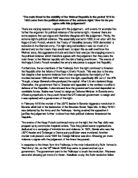The Golden Years of the Weimar Republic presented a faade of success which in reality masked serious underlying weaknesses. How far do you agree with this judgement?
‘The ‘Golden Years’ of the Weimar Republic presented a façade of success which in reality masked serious underlying weaknesses.’ How far do you agree with this judgement? (30)-
The Weimar Republic, led by Gustav Stresemann was traditionally seen as the ‘Golden years’ of Germany due to its façade of success. However, in reality, these successes masked serious underlying weaknesses through the economy, politics, foreign policy and social factors.
The economy served as the Republic’s greatest façade, causing many more underlying problems than successes. Arguably the biggest issue the Weimar Republic had in Germany was the hyperinflation of 1923. This hyperinflation caused: widespread poverty throughout Germany; the class status of many groups of people to be affected; unemployment and homelessness; political unrest and a loss of faith in the Weimar Government. Although Stresemann helped secure a remarkably quick recovery from this, by introducing the Rentenmark as the new currency and appointing Hjalmar Schacht and Hans Luther as the Head of Bank and Finance Minister respectively, this did not eradicate many of the issues and thoughts felt by the hyperinflation.
In order for a true recovery of hyperinflation to take place, industry had to thrive. This was hugely encouraged by foreign investment (notably from America). From this, the economy was boosted and Germany was receiving more in loans than they were paying out in reparations. However, this was all merely a façade disguising the downfalls of this foreign investment. Germany still remained in masses of debt, they were still obliged to pay the reparations and, due to the heavy investment in industry, agriculture was severely neglected, affecting how Germany could sustain herself. With this lack of balance financially, there was a high rise in unemployment in Germany in the 1920s. Indeed, in 1927 the Labour Exchanges were created and the Unemployment Insurance Law was passed. Despite these seeming like positive things that the Weimar Government had done, it was, again, a façade. With unemployment came more loans to be taken out and so Germany was still worse off. The Dawes Plan (1924) also appeared to bring increased financial stability, the staggered reparations it promised allowed the economy to grow sufficiently in order to be able to efficiently pay reparations. In 1924 Germany had to pay out 1000 million but received 800 million in loans. This allowed for a sense of more prosperity. Although problems started before the Wall Street Crash of 1929 and unemployment was already rising, it did serve to highlight the capricious nature of the German economy at this time. Despite the appearance of growing financial stability, this rested on foreign investment, which would never truly be sustainable, demonstrating that the economy of the Weimar ‘Golden Years’ was only a façade of success.








